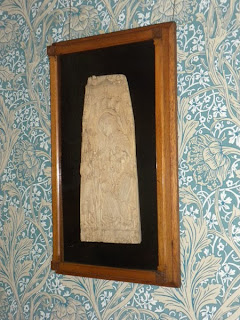On Saturday December 14th,
the museum opened the newest restored space on its public tours – the dining
room silver closet. This space, located
to the left of the fireplace in the dining room, had served as a simple storage
closet since the Glessners died in the 1930s and was in need of some attention. Thanks to a generous anonymous gift to the
museum’s 125th anniversary fund, the space has been restored to its
original appearance, and now showcases pieces from the Glessners’ large
collection of silver.
The restoration involved the
work of several talented craftsmen:
Historic paint analysis –
Robert Furhoff
Oak-framed glass enclosure –
Kevin Welter
Lighting consultant – Peter Hugh
Electrical – Block Electric
Wood refinishing – Lee Redmond
Painting and wall repair –
Shamrock Decorating
The display in the silver closet will change
from time to time, as there are many more pieces of silver in the museum
collection than can be displayed at any one time. These include pieces owned by John and
Frances Glessner, items owned by their daughter Frances Glessner Lee, and a
wonderful collection from the Fisk-Botsford-Harvey family that moved into their
nearby home at 2100 S. Calumet Avenue in 1885.
The display will also include several silver bags from Marshall Field
and other dealers from whom the Glessners purchased their pieces. Silver items would have typically been stored
in the closet in bags such as these to prevent tarnishing.
Three items that will remain on permanent
display in the closet are among the most special in the entire museum collection. These three pieces were handcrafted by
Frances Glessner in her silversmithing shop located in the basement of the
house, directly beneath the dining room.
We know from her journal that she began doing
her silver work in late 1904. An entry
dated October 28, 1904 reads “I went to call on Mrs. Wynne to arrange to take
lessons in metal work.” Mrs. Wynne was
Madeline Yale Wynne, a highly talented metal worker and a charter member of the
Chicago Arts and Crafts Society, founded at Hull-House in 1897. (For more information on her, see the blog article
dated August 29, 2011). Frances Glessner
also took lessons from Annibale Fogliata, a metal smith who taught at Hull-House.
She had her first lesson from Mrs. Wynne on November
29th and soon after made the salt cellar shown above as a gift for
her husband. The inscription on the
underside of the piece reads “Made by F.M.G. for J.J.G. Dec. 25th
1904.” It is one of the three pieces now
on display in the silver closet, all of which display her trademark features –
simple clean lines and visible hammer marks across the surface.
The largest piece on display is a calling card
tray, measuring 8-1/2 inches in length and featuring simple curved sides. For many years, the tray sat on the drum
table in the main hall, allowing lady visitors to leave their cards when paying
a call.
The third piece is a charming silver bowl with
an elegant scalloped edge. Frances
Glessner made the piece for her youngest granddaughter, Martha Lee, born in November
1906. The inscription reads “Martha Lee from FMG.” All three pieces were donated to the museum
by this granddaughter, later Martha (Lee) Batchelder.
Frances Glessner’s silver mark features her
initial “G” encircling a honeybee, the symbol of another of her favorite
hobbies – beekeeping. She actively
pursued her interest in metal work for about a decade – making countless pieces
and expanding to make jewelry as well, usually long chains set with
semi-precious stones. Her journal is
full of letters from thankful recipients, and it appears that most, if not all,
of the members of her Monday Morning Reading Class were among those to receive
one of these special hand-made gifts.
Today, this exhibit of her silver work is
another way in which we can interpret the life of this most fascinating
individual.

























